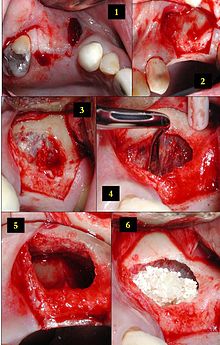- Maxillary sinus floor augmentation procedure
-
 1) Edentulous area of two missing teeth is being prepared for future placement of dental implants with a lateral window sinus lift; incisions into the soft tissue are shown here.
1) Edentulous area of two missing teeth is being prepared for future placement of dental implants with a lateral window sinus lift; incisions into the soft tissue are shown here.
2) The soft tissue is flapped back to expose the underlying lateral wall of the left maxillary sinus.
3) The bone has been removed with a piezoelectric instrument, exposing the underlying Schneiderian membrane, which is the lining of the maxillary sinus cavity.
4) Through careful instrumentation, the membrane is carefully peeled from the inner aspect of the sinus cavity.
5) The membrane has been reflected from the internal aspect of the inferior portion of the sinus cavity; one can now visualize the bony floor of the sinus cavity without its lining membrane (note the triangular ridge of bone within the sinus, known as an Underwood's septum).
6) The newly formed space within the bony cavity of the sinus yet inferior to the intact membrane is grafted with human cadaver allograft bone. The floor of the sinus will now be roughly 10mm or so more superior than it was before, providing enough room to place dental implants into the edentulous site.A maxillary sinus floor augmentation procedure[1] (sometimes known informally as a sinus-lift or sinus procedure) is a surgical procedure performed by an appropriately trained dentist or dental specialist to increase the amount of bone in the posterior maxilla, or upper jaw bone.
While there may be a number of reasons for wanting a greater volume of bone in the posterior maxilla, the most common reason in contemporary dental treatment planning is to prepare the site for the future placement of dental implants.
Contents
History
The first maxillary sinus floor augmentation procedure was performed by Oscar Hilt Tatum, Jr. in 1974.
Surgical techniques
Complications
References
- ^ Boyne, PJ. De novo bone induction by recombinant human bone morphogenetic protein-2 (rhBMP-2) in maxillary sinus floor augmentation. J Oral Maxillofac Surg 2005;63:1693-1707
- Raghoebar GM, Timmenga NM, Reintsema H, Stegenga B, Vissink A. Maxillary bone grafting for insertion of endosseous implants: results after 12–124 months. Clin Oral Implants Res 2001; 12(3): 279-86. PMID 11359486
- "Bilateral Sinus Lifts with SynthoGraft Using Floor Transport Technique with Sinus Lift Temporary Abutments, Two Stage Placements, and Restoration with Twelve Maxillary Full Arch Integrated Abutment Crowns". http://www.bicon.com/cases/GWH.html.
- Chen, Leon, & Cha, Jennifer, An 8-Year Retrospective Study: 1,100 Patients Receiving 1,557 Implants using the Minimally Invasive Hydraulic Sinus Condensing Technique, 'Innovations in Periodontics, Volume 76, Number 3, March, 2005
- "Journal of Periodontology March 2005, Vol. 76, No. 3, Pages 482-491". http://www.joponline.org/doi/abs/10.1902/jop.2005.76.3.482?journalCode=jop.
- Abrahams, James J. (2000). Sinus Lift Procedure of the Maxilla in Patients with Inadequate Bone for Dental Implants American Journal of Roentgenology. 174. pp. 1289–1292. http://www.ajronline.org/cgi/content/full/174/5/1289 Sinus Lift Procedure of the Maxilla in Patients with Inadequate Bone for Dental Implants.
External links
Educational Resources
- OsseoNews.com A detailed discussion on sinus lift procedures.
- Sonosurgery.it Documented cases on sinus lift procedures with sonical instruments.
Categories:- Dentistry procedures
- Sinus surgery
Wikimedia Foundation. 2010.
